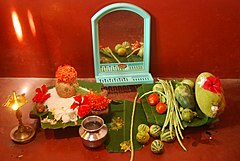Bisu Parba
| Bisu Parba | |
|---|---|
 Bisu Kani at Puttur | |
| Official name | Bisu Parba |
| Observed by | Tuluvas |
| Type | Religious, Social |
| Observances | Bisu kani Bisu Parbo |
| Begins | dawn |
| Ends | after 24 hours |
| Related to | Bihu, Bwisagu, Baisakhi, Pohela Boishakh, Puthandu, Pana Sankranti |
Bisu Parba (Tulu: ಬಿಸು) is a harvest festival of Tulunadu. Celebrated as the new year for this region as per their Tulu Calendar. It falls on the month of Paggu first in the regional calendar.[1][2]
Background
This is a key annual festival for people for Tulu Nadu. It is a form of worship of Nature. It is believed that this day is an auspicious day for the commencement of projects. The people of Tulunadu celebrate the Bisu festival as a symbol of prosperity of the year past and hoping to prosper throughout the upcoming year. This festival is known as Bisu Parba in Tulu Nadu.[3]
Celebrating

Get up early in the morning on the day of the feast and put it on the bed in the chamber of God or in the hall. Light the foot lamp and put it in two ends, keep banana leaves and placed one cup of rice, two betel leaves, one semi dehusked coconut with muganda, a bunch of Ixora coccinea (also known as jungle geranium Tulu: Kepula poo) stick of sandalwood, and wet the sandalwood which totally called suthye dipuna. In front of this suthye grown vegetables, flowers, hinges, fruits, gold ornaments, mirrors.
Blessings of the elder

All the householders pray together and worship God in front of Bisu Kani. Reconciliation with family members as well as relationships between seniors and juniors. The juniors receive the blessings of the elders on this occasion. Touching the feet of elders is an age-old Indian tradition that is considered to be a mark of respect as well as blessing. This gesture can be seen in almost all Tuluva families on this occasion. The elders of the house give money to all the minors and they enjoy the feast. Every year, it is a source of good fortune. As part of the Bisu festival, special worship is held in daivaradane chavadi, temples and the sacrificial festival of God. It is common to prepare and enjoy a traditional dish for this special day. Everybody has to go to every house and enjoy the food with the blessings of the elders. The owner of the house after putting the Bisu kaṇi (arrangement of fruits, vegetables) on the roof of the house.
Bisu Kani
The festivals in Tulunadu highlight the farmer's life and his affinity with the land he tills[4]., On the day of the feast, bed of wooden in the chamber of God, daiva or in the hall. Light the foot lamp and put it in two ends, banana leaves placed on floor or bed of wooden is accommodate one pot of water, one cup of rice,two betel leaves, one semi dehusked coconut(with muganda), a bunch of Ixora coccinea (also known as jungle geranium Tulu: Kepula poo) stick of sandalwood, and wet the sandalwood which totally called suthye dipuna. In front of this suthye grown vegetables, flowers, hinges, fruits, gold ornaments, mirrors. tenants were taking the grown vegetables to his boss (Tulu: Danikulu) such as brinjal, cucumber, sambar southe, pumpkin, ivy gourd, long yard beans, bottle gourd, okra, and fruits such as jackfruit, banana, cashew apple, jambu nerale, mango, pineapple. Arecanut and coconut, the part and parcel of local life, was also part of the Kani.[5]
Bisu Parba Recipe

On the occasion of Bisu people are resting at home and preparing special food for breakfast on the day which is mostly "Moode recipe" (English: Screw Pine) which is similar to Kadubu and “Uddina dōse recipe” (lentil dosa). For lunch, cashew nut and green gram curry (Bijata Kajipu), cucumber puli kajipu, Ivy gourd dry palya fries and Payaso is served with steamed boiled rice and other accompaniments. Prepare a Tuluva inspired brunch this "Bisu Parba and enjoy with the members of the family.[6]
Kai Bittu Padune
Bisu parbo is auspious day for Tuluvas, so on this day morning they keep a side new paddy seeds[7]. In the evening sowing procedure is carried out on the chin(tulu:Puṇi) of field. Put the paddy seed on the side of the mulch and shade it with Aporosa villosa (Tulu: Saroli) leaves. And tenants take permission for continuing the practice of planting the following year.[8]
References
- ^ "Souramaana Yugaadi, Bisu Parba, Vishu and Tamil New Year". Retrieved 14 March 2020.
- ^ Apr 14, TNN. "Mangalore: Bisu Parba, Solar New Year, was celebrated with traditional gaiety | Mangaluru News - Times of India". The Times of India. Retrieved 14 March 2020.
{{cite web}}: CS1 maint: numeric names: authors list (link) - ^ "Bisu Parba celebrated with traditional pomp, gaiety". Deccan Herald. 14 April 2018. Retrieved 14 March 2020.
- ^ ತುಳುವೆರೆ ಬಿಸು ಪರ್ಬ, April 13, 2008
- ^ "Bisu Parba - traditional ceremony observed with pomp and gaiety". mangaloretoday.com. Retrieved 14 March 2020.
- ^ Matt, Suprabha S. "Celebrate Bisu Parba With Tulunadu Inspired Appealing Brunch Menu". Archana's Kitchen. Retrieved 14 March 2020.
- ^ Tulunadina Sasya Janapada by B Shivarama Shetty PHD, Mangaluru University, 1992 P.240
- ^ Guttu Mane helps people relive fervour of Bisu Parba, Apr 15, 2018,
